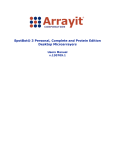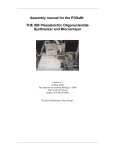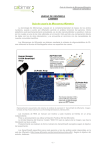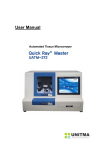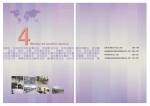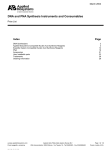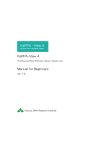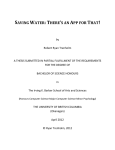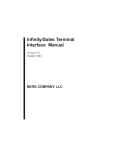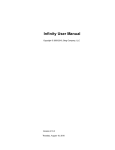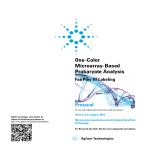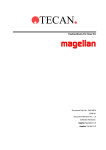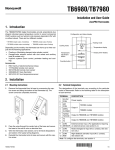Download NSB Amine Slide
Transcript
NSB Amine Slide USER MANUAL HANDLING AND STORAGE INSTRUCTIONS Ö NSB Amine Slides as received can be stored in a desiccator at room temperature for one year. Ö After opening the package, it is recommended that the slides be kept in a desiccator and used within six months for optimal outcome. Ö Use the slides in a clean environment, since dust particles may cause problems. Ö Avoid direct contact with the surface while handling. Hold the sides or edges of the slide and use only powder free gloves to minimize contamination and damage to the coating. PRODUCT USE LIMITATIONS NSB slides are sold for research purposes only and are not intended for resale. This product is not to be used in human diagnostics or for drug purposes in any way. Certain arrays and/or methods of preparation, analysis or use may be covered by intellectual property rights in certain countries. Use of this product is recommended only for applications for which the user has a license under proprietary rights of third parties or for technology for which a license is not required. If you intend to use NSB slides for commercial purposes, please contact us. PROTOCOL 1. SLIDE ACTIVATION PROCESS Prepare reagents & solvents - Di(N-succinimidyl)carbonate (DSC) - Diisopropylethylamine (DIPEA) - Anhydrous acetonitrile - Dimethylformamide (DMF) - Ethanol • Prepare 10 - 20 mM solution of di(N-succinimidyl)carbonate (DSC), containing 0.1% (v/v) DIPEA (diisopropylethylamine) in acetonitrile. Ex) 0.5 - 1g DSC in 200 ml acetonitrile and 0.2 ml DIPEA • Place the NSB Amine Slides in the above solution 1 • Incubate it at room temperature (r.t.) for 4 hour. (Anhydrous environment is optional but recommended to protect the activated slide) • Wash the slides with dimethylformamide (DMF) and then immerse them in DMF. Stir the solution at r.t. for 20 mins or sonicate the solution at r.t. for 2 mins. • Wash them briefly with ethanol, dry using a nitrogen gas blower or a slide drier, and keep under vacuum or under nitrogen atmosphere until spotting. Storage: The activated slides can be stored under vacuum at r.t. for a week and under nitrogen atmosphere for two days. However, it is recommended to activate the slides with DSC just before array fabrication. 2. ARRAY FABRICATION Prepare spotting buffer & washing buffer - Spotting buffer: 25 mM NaHCO3 and 5.0 mM MgCl2 in sterile D.I. water (pH 8.5, 10 % DMSO). - Washing buffer B: 2X SSC and 0.20 % SDS Note : Use of over 10 % DMSO decreases the amounts of surface immobilized oligonucleotides leading to lower hybridization signal. • Dissolve oligonucleotides to make 10 - 50 µM concentration in Spotting buffer. Transfer the DNAs to 96 or 384 well microplate(s). (20 µM is recommended.) • Set up microarrayer and print slides according to the manufacturer’s or laboratory protocol. The printing environment should be dust free, kept at temperature below 25 oC and at a relative humidity between 50 and 80 %. • Incubate the printed arrays at 80 % relative humidity (in a humidity chamber or in the printing instrument) kept at ambient temperature (20 - 25 oC) for over 3 hours (Overnight incubation is recommended.). The humidity chamber can be made by using a saturated salt solution enclosed in an airtight container such as a glass desiccator jar. A small glass dish or cotton wool can be used to hold the saturated salt solution at the bottom of the container. • Place the slides in a slide holder and immerse in Washing buffer B. Keep the buffer stirred at 37 oC for 10 - 20 min. Wash the slides with DI water. Dry them using a nitrogen gas blower or a slide drier and store at 4 oC. 2 Note: The arrayed slides can be stored at 4 oC under anhydrous environment (for example, under nitrogen environment or in a desiccator) for at least 3 months before hybridization. 3. HYBRIDIZATION It is well known that optimal hybridization and washing temperatures and times for DNA microarrays are dependent on the melting temperatures of DNA duplexes which are effected by salt concentrations and detergent or formamide amounts in buffer solutions. Users are recommended to optimize the appropriate hybridization and washing conditions for the best DNA microarray results. Standard examples for SNP genotyping and gene expression profiling are described below. Prepare hybridization & washing buffer - Hybridization buffer A (for SNP genopyping) : NaCl (300 mM), Na2HPO4 (20 mM), EDTA (2.0 mM) and SDS (7.0 mM) in sterile D.I. water (pH 7.4). - Hybridization buffer B (for gene expression profiling) : 3.5X SSC and 0.30 % SDS - Washing buffer A: 1X PBS - Washing buffer B: 2X SSC and 0.20 % SDS - Washing buffer C: 0.2X SSC 3-1. SNP genotyping 3-1-1. Protocol for a microarray with short oligonucleotides (15 - 25mer) using a hybridization machine, HS 400 (TECAN) • Make appropriate concentration of target oligonucleotides or PCR products using Hybridization buffer A. Typically the assay volume of target DNA solution is determined by the size of the hybridization chamber. • Keep the slides in hybridization chambers of the machine, insert target solution, denature target DNAs at 90 oC for 1 min, and hybridize the slide at 45 - 55 oC for 1 min - 4 hour. Denaturation function supplied by a hybridization machine can provide good hybridization performance. • After hybridization, it is recommended to wash the slides according to the below process Washing program for TECAN HS 400 model 3 1. Flow Hybridization buffer A at 45 - 55 oC for 30 sec 2. Hold Hybridization buffer A at 45 - 55 oC for 1 min 3. Repeat Steps 1 & 2 4. Flow Washing buffer A for 10 sec 5. Dry for 30 sec • Store the slides and protect them from light until scanning. 3-1-2. Protocol for a microarray with short oligonucleotides (15 - 25mer) using a Agilent microarray chamber kit (G2534A) • Make appropriate concentration of target oligonucleotides or PCR products using Hybridization buffer A. Typically the assay volume of target DNA solution is determined by the size of the hybridization chamber. • Load denatured target solution onto a gasket slide and carefully put an oligo microarray slide on top of the gasket slide. • Keep the chamber in a hybridization oven and incubate at 45 - 55 oC for 1 min - 4 hour. • After hybridization, wash the slides with Hybridization buffer A at 45 - 55 oC for 3 - 10 min followed by Washing buffer A for 10 sec or D.I. water for ~ 3 sec and dry them using a nitrogen gas blower or a slide drier. • Store the slides and protect them from light until scanning. Note: Please refer to Agilent microarray hybridization chamber user guide for detail direction of Agilent microarray chamber kit (G2534A). 3-2. Gene expression profiling 3-2-1. Protocol for a microarray with long oligonucleotides (50 - 80mer) in a hybridization machine like HS 400 (TECAN) • Make appropriate concentration of cDNA using Hybridization buffer B. Typically the assay volume of target DNA solution is determined by the size of your hybridization chamber. • Keep the slides in hybridization chambers of the machine, insert cDNA solution, denature cDNA at 90 oC for 1 min, and hybridize the slide at 40 - 65 oC for 12 - 16 hour. Denaturation function supplied by a hybridization machine can provide good hybridization performance. • After hybridization, it is recommended to wash the slides according to the below process 4 Washing program for TECAN HS 400 model 1. Flow Washing buffer B at 37 oC for 30 sec 2. Hold Washing buffer B at 37 oC for 1 min 3. Repeat Steps 1 & 2 4. Flow Washing buffer C at 25 oC for 10 sec 5. Dry for 30 sec • Store the slides and protect them from light until scanning. 3-2-2. Protocol for a microarray with long oligonucleotides (50 - 80mer) using a Agilent microarray chamber kit (G2534A) • Make appropriate concentration of cDNA using Hybridization buffer B. Typically the assay volume of target DNA solution is determined by the size of the hybridization chamber. • Load denatured cDNA solution onto a gasket slide and carefully put an oligo microarray slide on top of the gasket slide. • Keep the chamber in a hybridization oven and incubate at 40 - 65 oC for 12 - 16 hour. • After hybridization, wash the slides with Washing buffer B at 37 oC for 3 - 10 min followed by Washing buffer C for 10 sec, and dry them using a nitrogen gas blower or a slide drier. • Store the slides and protect them from light until scanning. Note: Please refer to Agilent microarray hybridization chamber user guide for detail direction of Agilent microarray chamber kit (G2534A). REFERENCE 1) V. Sunkara, B. J. Hong, J. W. Park, “Sensitivity Enhancement of DNA microarray on Nanoscale-Controlled Surface”, Biosensors and bioelectronics 22(7), 1532-1537 (2007). 2) S. J. Oh, B. J. Hong, K. Y. Choi, and J. W. Park, “Surface Modification for DNA and Protein Microarrays”, OMICS: A journal of Integrative Biology 10(3), 327343 (2006) 3) B. J. Hong, V. Sunkara, J. W. Park, “DNA Microarrays on Nanoscale-Controlled Surface with a Dendron”, Nucleic Acids Research 33(12), e106 (2005). 4) S. J. Oh, J. Ju, B. C. Kim, E. Ko, B. J. Hong, J. Park, J. W. Park, K. Y. Choi, “DNA Microarrays on a Dendron-Modified Surface Improve Significantly the Detection of Single Nucleotide Variations in the p53 Gene”, Nucleic Acids Research 33(10), e90 (2005). 5 5) B. J. Hong, S. J. Oh, T. O. Youn, S. H. Kwon, J. W. Park, “NanoscaleControlled Spacing Provides DNA-microarrays with the SNP Discrimination Efficiency in Solution Phase”, Langmuir 21, 4257-4261 (2005). For detailed technical support or additional information, please contact us! Our special DNA microarray team can help you! NSB POSTECH www.nsbpostech.com E-mail: [email protected] or [email protected] Phone: +82-54-279-8416, Fax: +82-54-279-8419 6






